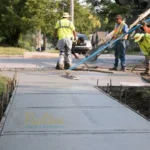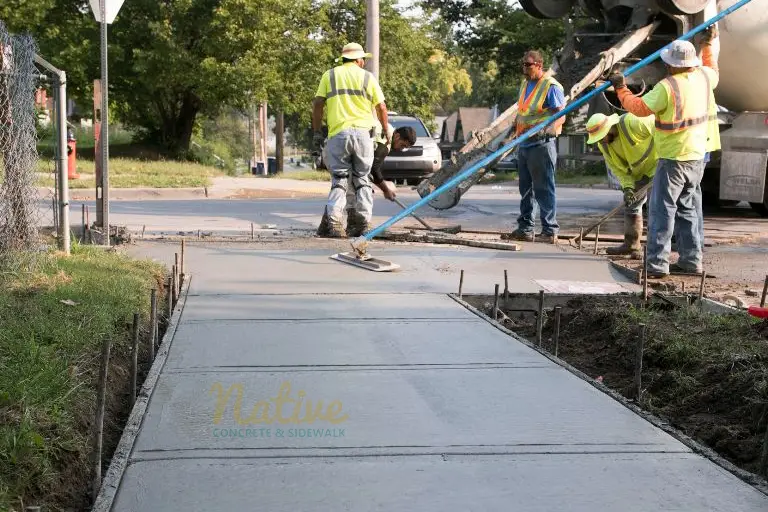Overview
Sidewalks are among the most exposed elements of a property, and their year-round exposure to extreme weather conditions often leads to premature wear and tear. From icy winters to sweltering summers, concrete surfaces face constant pressure that can lead to cracks, scaling, or spalling if not properly maintained. Preventative care and smart seasonal practices can extend the life of your sidewalk, preserving its appearance, safety, and functionality. Whether you’re dealing with snow, freezing temperatures, or high heat and heavy rainfall, certain steps can make all the difference. We will explore some essential contractor-recommended tips that help homeowners and property managers protect their sidewalks during severe weather conditions and avoid costly repairs.
Concrete Care Tactics Every Homeowner Should Know
1. Seal Your Sidewalk Before Winter Arrives
Applying a high-quality concrete sealer before the onset of cold weather is one of the most effective ways to protect your sidewalk, especially in a place like New York City, where winters can be particularly harsh. Sealing provides a protective layer that repels water, reducing the chance of moisture penetrating the concrete surface. This is critical because when water seeps into the pores of the concrete and then freezes, it expands, causing cracks and breakage over time—a process known as freeze-thaw cycling.
A sealer minimizes this risk by creating a barrier against moisture, salt, and de-icing chemicals. It’s important to apply the sealer when the concrete is clean and dry, typically during early autumn when temperatures are moderate. Sealers should be reapplied every few years, depending on the level of traffic and exposure. By incorporating this into your seasonal preparation, you ensure your sidewalk has an added layer of protection when winter takes its toll.
2. Use the Right De-Icing Methods During Snowfall
While it’s tempting to throw down rock salt at the first sign of snow or ice, not all de-icing agents are concrete-friendly. Traditional sodium chloride (rock salt) can cause concrete to deteriorate, especially in newer sidewalks less than a year old. It also contributes to surface scaling and encourages internal moisture retention that can lead to cracking. Instead, consider using calcium magnesium acetate or sand, both of which provide traction without causing chemical damage.
Additionally, shoveling snow promptly before it turns to ice can reduce the need for de-icing altogether. If you must use a de-icer, apply it sparingly and avoid stacking excess snow treated with salt near sidewalk edges. After winter, rinse the sidewalk thoroughly to remove any residual chemicals. Responsible winter maintenance not only preserves your sidewalk’s surface but also contributes to pedestrian safety and long-term concrete stability.
3. Address Minor Cracks Before They Worsen
Cracks in your sidewalk may seem minor during dry weather, but once moisture, ice, and temperature fluctuations are involved, they can quickly grow into larger, more costly problems. Early detection and repair are crucial to maintaining your sidewalk’s structural integrity in harsh conditions. Use a concrete filler or patching compound to seal hairline or minor cracks before they expand and worsen. These products are often easy to apply with a caulking gun or putty knife and can be found at most hardware stores. After patching, consider applying a new coat of sealer over the repaired areas to reinforce protection. Cracks not only undermine your sidewalk’s appearance but can also create tripping hazards, so timely repairs are a matter of safety as well. Regular inspections in the spring and fall help catch problems early, giving you a chance to make small fixes before they become major reconstruction jobs.
4. Ensure Proper Drainage Around Your Walkway
Water pooling around or under your sidewalk can dramatically weaken its foundation, especially during freeze-thaw cycles or in heavy rainy seasons. Poor drainage is a significant contributor to the shifting, sinking, and cracking of sidewalks. To combat this, ensure your sidewalk is slightly sloped to allow water to run off instead of collecting on its surface. Check nearby gutters and downspouts to ensure they are directing water away from your walkway. If your sidewalk is adjacent to your lawn or garden, ensure the soil is properly graded to prevent water from seeping under the slab. Installing gravel trenches or French drains nearby can also help redirect water flow during storms. Preventing standing water not only guards your sidewalk’s structural integrity but also reduces the risk of slippery surfaces, mold growth, and frost damage.
5. Avoid Heavy Loads and Equipment on Sidewalks
Concrete sidewalks are designed for pedestrian use, not for supporting the weight of vehicles, heavy machinery, or construction equipment. During wet or freezing weather, concrete becomes even more susceptible to damage from excessive weight. Avoid driving or parking cars, moving dumpsters, or storing heavy building materials on sidewalk sections, particularly during colder months. Even during a summer renovation project, equipment should be kept off the walkway to prevent cracking or indentation.
If heavy deliveries or construction work are unavoidable, consider using plywood sheets to distribute the weight more evenly across the surface. This simple precaution can prevent long-term damage that may otherwise lead to complete replacement. Being mindful of what your sidewalk supports throughout the year is a proactive way to extend its service life and maintain its clean, level appearance.
Protecting your sidewalk from harsh weather doesn’t require expensive interventions, but it does call for consistent care and smart seasonal strategies. From sealing the concrete before winter to ensuring effective drainage and avoiding excessive weight, each step contributes to the long-term durability of your walkway. Small investments in upkeep now can save you from major repairs or replacements down the road. By staying proactive and informed, homeowners can preserve the value, safety, and appearance of their property’s concrete surfaces—even when faced with the most unpredictable elements.











